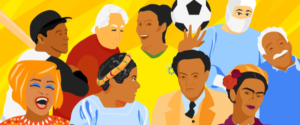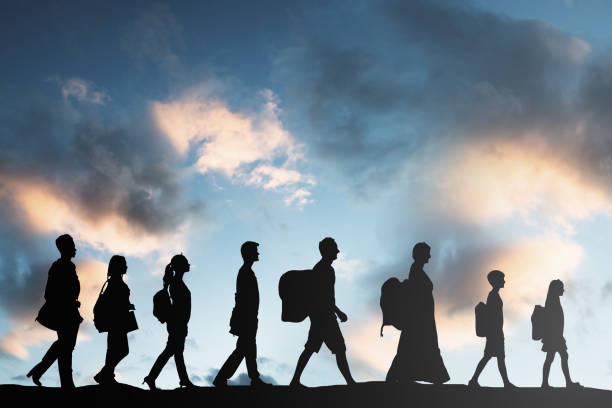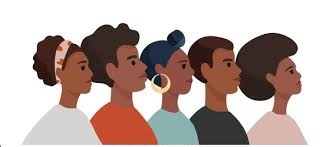THE COMMUNITIES OF COLOR

LATINO AND HISPANIC
Latino and Hispanic cultural groups have a long history in Ohio. Early migration was driven predominantly by Puerto Ricans who migrated to Lorain, Ohio, in 1947 in response to a concerted recruiting campaign by the National Tube Company (Schouten, 2020). Between 1960 and 2006, distinct Latino/ Hispanic communities formed in several major Ohio cities as they found employment in factories, on farms, or by successfully opening restaurants and specialty stores (Van Tassel & Grabowski, 1996). Self-identified Mexicans began the second significant wave of Latino/Hispanic immigration to Ohio in 2000. Since then, the Mexican communities has more than doubled, with nearly 195,000 people having an ancestral link to Mexico and more than 10,000 people arriving from Mexico in the last decade (U.S.Census Bureau, 2018b). These recent population shifts have also been driven by employment opportunities in the agriculture, food, and service industries (Johnson-Webb, 2003; Kandel & Parrado, 2005).
Despite consistent, successful immigration to Ohio, members of the Latino/Hispanic population face discrimination and the pressure to assimilate into American culture (Cohen & Chavez, 2015). Cultural bias destabilizes the economic, education, and health status of Latino/ Hispanic populations. Accordingly, communities members have identified priority needs for eliminating socioeconomic and health disparities. These include access to monetary security, transportation, and resolution of immigration status – a significant factor as undocumented status often results in a lack of health insurance (Kouyoumdjian et al., 2006). These challenges are somewhat alleviated through solid community connections that allow Latino/Hispanic groups to maintain some traditional values and customs and provide resources in times of need (Cohen & Chavez, 2013; Mora, 2014).


NEW AMERICAN/IMMIGRANT
French and British colonialists were the first immigrants to Ohio (Ohio History Connection, 2020b). The second wave of immigration in the 1800s included settlers from western Europe (e.g., Germany, Ireland, and Italy) and eastern Europe (e.g., Russia, Poland, and Hungary). Starting in the 1940s in the wake of World War II, Ohio experienced an increase in immigrants with Jewish ancestry (Aumann et al., 2020) and an increase in immigration from a greater diversity of origin countries.
About 5.0% of refugees in the U.S. are resettled in Ohio, such that between 1983 and 2013, 45,392 refugees were resettled in the state. There are refugee communities in all major Ohio cities, but most reside in five counties: Cuyahoga, Franklin, Hamilton, Montgomery, and Summit (ODJFS, 2018). The primary refugee communities in central Ohio include Afghani, Bhutanese, Nepali, Burmese, Congolese, Ethiopian, Eritrean, Iraqi, Somali, Syrian, and Ugandan peoples (Communities Refugee & Immigration Services, 2020)
The Somali communities, which comprises many refugees in Ohio, experiences specific healthcare access barriers, including limited language fluency, lack of healthcare insurance, and cultural practices that limit engagement with U.S. healthcare providers (e.g., female circumcision) (Banke-Thomas et al., 2019). Latino/Hispanic immigrants in Ohio also experience barriers to accessing healthcare. For example, Latino immigrants living in Cincinnati have described fear of seeking healthcare services due to discrimination and racism in the healthcare setting and, specifically, healthcare providers (Jacquez et al., 2016). Their experiences highlight a need for more Spanish-speaking doctors, important cultural competency education for healthcare providers, and a pathway for ensuring undocumented individuals.

INDIGENOUS PEOPLE
Indigenous peoples inhabited the land now in Ohio as early as 15,000 years ago. The pre-historic Mound Builders were here for centuries, perhaps dating back to the same time as when the Great Pyramids in Egypt were built. Over the centuries, the Mound Builders civilization grew and expanded throughout much of Ohio. Large communities with 1000s of inhabitants sprang up in various areas across the state. Then within a short period, the Mound Building culture disappeared from Ohio. By the time Christopher Columbus was setting foot in the Caribbean, the Mound Builders and their practice of building earthworks had disappeared entirely from Ohio. It would take almost a century before Native Americans would enter Ohio and establish hunting camps. The last Native American reservations in Ohio were dismantled in the 1840s (Ohio History Connection, 2020b).
The original inhabitants of Ohio consisted primarily of three nations: the Erie, Kickapoo, and Shawnee, the first two residing in areas near modern-day Toledo. The Kickapoo tribe branched out from a part of the Shawnee tribe. Linguists speculate that the word “Kickapoo” is a reinterpretation of the Shawnee word for wanders ” They refused to assimilate to colonization when European settlers first arrived. Still, the settlers later forced the Kickapoo to relocate further south and out of Ohio. The Kickapoo soon immigrated to reservations located in other states.
The Erie tribe is no longer around after being defeated in war by the Iroquois Confederacy in 1654. Survivors merged with the Huron-Wyandot nation or were captured by the Iroquois and Seneca tribes.
In the mid-1600s, the Shawnee also traveled due to pressure from the Iroquois and American settlers. With other Ohio Valley tribes in parts of the southern region also under stress from the Iroquois Confederacy and European-American colonization, Shawnee leader Tecumseh and his brother Tenskwatawa tried to unite eastern tribes under a movement called the Pan-Indian Unity in the early 1800s. The alliance allowed the tribes to band together to fight against colonization until it was dissipated by Americans shortly after Tecumseh was defeated in the Battle of Thames in 1813. This forced the Shawnee tribe to relocate to Oklahoma.
More than 100,000 Native children suffered the direct consequences of the federal government’s policy of forced assimilation using Indian boarding schools during the nineteenth and twentieth centuries.


BLACK AND AFRICAN AMERICAN
Black and African Americans have been part of Ohio’s history since the state’s creation in 1787 (University of Akron, 2008). In 1830, approximately 9,600 Black and African Americans resided in Ohio; by 1950, this group represented 6% of the state’s total population. Black and African American Ohioans have always faced considerable racism, discrimination, and violence. In the early 1800s, Ohio legislators passed the “Black Laws,” which required any Black person to post a $500 bond to gain entry into the state. These laws also restricted employment opportunities for Black Americans and prevented them from voting, serving on juries, testifying against Whites, and enrolling their children in public school (Middleton, 2005). A hundred years later – in the 1920s – support for the Ku Klux Klan (KKK) rose in Ohio, and Klan members were elected to public office in some major cities, including Akron (Ohio History Connection, 2020a).
At the same time, Black Americans were actively prohibited from living in White neighborhoods (by redlining and other widespread discriminatory policies). They were frequently subjected to discrimination in public spaces (WOSU Public Media, 2017). These and other forms of historical and systemic oppression in Ohio – as in the country– have had long-term health, economic, and social impacts on Black and African American communities. Black and African Americans have also been subject to state-sponsored racism in the form of medical experiments.
Throughout the 20th century, the U.S. government-sponsored several unethical research studies on Black Americans (Washington, 2006). The most famous of these was the Tuskegee experiment, from 1932 to 1972 in Tuskegee, Alabama. The U.S. Public Health Service (PHS) funded the Tuskegee experiment to study the natural progression of syphilis, recruiting 600 Black men with promises of free health care for various ailments (Nix, 2019). PHS doctors lied to participants about the study’s goals throughout its duration and actively prevented them from receiving syphilis treatment. By the end of the study, 138 participants had died from syphilis or related complications. Unfortunately, similar unethical experiments also took place in Ohio.
In 1952, more than 180 healthy Black inmates at the Ohio State Prison were injected with live cancer cells as part of a clinical study funded by the National Institutes of Health (NIH) (Johnson, 2018). Study leader Dr. Chester M. Southam of the Sloan-Kettering Institute misinformed inmates about participating in the experiment (Alliance for Human Research Protection, 2014). Two decades later, Dr. Eugene L. Saegner of the University of Cincinnati exposed 88 cancer patients – of whom 60% were Black, and 3 were children – to high doses of radiation in a study funded by the Department of Defense. Twenty-five patients died within the first two months of the experiment (Healy, 1994; Advisory Committee on Human Radiation Experiments, 1996).

ASIAN AND PACIFIC ISLANDER
The immigration of sizable numbers of people from Asian countries to the United States began in the 1850s, mainly for jobs on farms, railroads, and gold mines (Klingle, 2020). Others arrived as scholars and business merchants. Immigration from Asian countries was substantially slowed by the 1924 National Origins Act and remained stagnant for more than 40 years (Klingle, 2020). The Immigration and Nationality Act of 1965 removed restrictions, leading to a wave of Asian immigration; the later United States Refugee Act of 1980 advanced Asian American immigration by supporting refugees’ resettlement, mainly from Southeast Asia. Consequently, there have been significant increases in Asian immigration to the U.S. during the last decades of the 20th and first decades of the 21st centuries (Hobbs & Stoops, 2002).
The first Asian Ohioans were descendants of Chinese immigrants who had previously settled on the west coast and moved into Cleveland (Van Tassel & Grabowski, 1996). There is also documentation of a small number of Indian Americans, mostly students, living in Cleveland as early as the 1920s (Van Tassel & Grabowski, 1996). Cleveland’s Chinatown originated as early as the 1860s, growing into present-day AsiaTown as different groups of refugees and immigrants seeking economic opportunity moved into the area (Case Western Reserve University, 2020; Van Tassel & Grabowski, 1996). Japanese Americans moved from the west coast to Midwest cities, including Cleveland, after World War II; Korean Americans, Vietnamese Americans, and other Asian American ethnic groups, including those from Bangladesh, Bhutan/Nepal, Cambodia, Indonesia, Laos, Malaysia, Myanmar, Pakistan, the Philippines, Singapore, and Thailand have resettled in Ohio since the 1960s (Van Tassel & Grabowski, 1996; Ohio Asian American Health Coalition, 2016).
Like other people of color in the U.S., throughout their histories in the country, Asians and Asian Americans have experienced structural and interpersonal oppression, including hate crimes, exclusionary policies, and deportations. The 1882 Chinese Exclusion Act banned immigration and prohibited citizenship of Chinese workers and their American-born children; these restrictions were enforced into the 1940s and extended over time to other Asian groups, including Japanese, Asian Indians, Filipinos, and Koreans (PBS, 2001). Japanese Americans, including citizens, were also imprisoned in internment camps during WWII (PBS, 2001).


